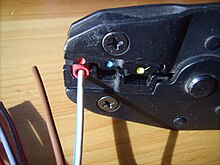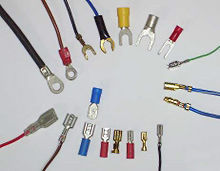Crimp (electrical)
This article needs additional citations for verification. (February 2011) |
An electrical crimp is a type of solderless electrical connection.
Crimp connectors are typically used to terminate stranded wire.[citation needed] The benefits of crimping over soldering and wire-wrapping include:
- A well-engineered and well-executed crimp is designed to be gas-tight, which prevents oxygen and moisture from reaching the metals (which are often different metals) and causing corrosion.
- Because no alloy is used (as in solder) the joint is mechanically stronger.[1]
- Crimped connections can be used for cables of both small and large cross-sections, whereas only small cross-section wires can be used with wire-wrap.[1]

In the first step of crimping, the terminal is inserted into the crimp tool. In the second step, the wire is inserted into the terminal.

In the third step, the handles of the crimp tool are squeezed together, compressing and reshaping the terminal until it is cold-welded onto the wire.

The resulting connection may appear loose at the edges of the terminal, but this is desirable so as to not have sharp edges that could cut the outer strands of the wire. If executed properly, the middle of the crimp will be swaged or cold-formed.

More specialized crimp connectors are also used, for example as signal connectors on coaxial cables in applications at high radio frequencies (VHF, UHF).
History
According to one of the crimp tool manufacturers, the development of standardized crimp tools and procedures occurred on this timeline.[2]
- 1940's All terminations were soldered (Hard-wired)
- 1953 AMP introduced Crimp Barrel Terminals
- 1957 Cannon Brothers experimented with Machined Contacts with Crimp Barrels
- 1960 Buchanan introduced the MS3191-1 4 Indent Crimp Tool with a Ratchet[3]
- 1963 MS3191-1 was published as the first Crimp Tool Standard
- 1965 MS3191-4 introduced by Daniels Manufacturing Corporation
- 1969 MIL-T-22520 published and dated to replace all previous specifications
- 1974 Changed to MIL-C-22520, and many Slash Sheets added
- 1996 Changed to MIL-DTL-22520
- 2010 Changed to AS22520[4]
Types of crimps
Styles:
- Insulated vs. Non-Insulated terminals
- wire crimp vs. insulation crimp
Crimp shapes:
- C crimp[5]
- D crimp[6]
- F crimp[5][6] (a.k.a B crimp) originally designed and named by AMP Incorporated, used only on non-insulated connectors, such as Packard 56, Weather Pack, and Metri Pack
- O crimp[7]
- W crimp[7][8]
- Overlap/OVL crimp[7]
- Oval (confined) crimp[7]
- Four-Mandrel crimp[7]
- Mandrel (crescent) crimp[7]
- Mandrel crimp-narrow (indented)[8]
- Hexagonal crimp[7][9]
- Mandrel (indent) crimp
- Square crimp[7][9]
- Trapezoidal crimp[7][9]
- Trapezoidal indent crimp[9]
- Trapezoidal crimp front[8]
- Tyco crimp[8]
- Western crimp
Judging crimp quality
A crimped connection will only be reliable if a number of criteria are met:
- All strands have been deformed enough, into roughly a trapezoidal shape, to cold-flow into the terminal body[10]
- The compression force is not to light, nor too strong[11]
- The connector body is not overly deformed
- Large voids are not left inside the crimp (caused by not enough wire inside the connector)
- The wire should have as many wires as possible, so that a few damaged or uninserted wires will not adversely affect the crimp density, and thus degrade the electrical and mechanical properties of the connection.[1]
Various examples of good and bad crimps exist. These typically provide a micrograph of the crimped connection, which is an assembled connection that has been cut in cross-section and then polished.
Crimp tools
A wide variety of crimpers (a.k.a. crimp pliers) exist, and they are generally designed for a specific type and size of terminal.





Simple crimp connectors
They fulfill numerous uses, including allowing the wires to be easily terminated to screw terminals, fast-on / quick-disconnect / spade-foot type terminals, wire splices, or various combinations of these. A tube-shaped connector with two crimps for splicing wires in-line is called a butt splice connector. Crimp-on connectors are attached by inserting the stripped end of a stranded wire into a portion of the connector, which is then mechanically deformed / compressed (crimped) tightly around the wire.[12] The crimping is accomplished with special crimping pliers. A key idea behind crimped connectors is that the finished connection is gas-tight.
Crimped connections fulfill similar roles, and may be thought of similarly, to soldered connections. There are complex considerations for determining which type is appropriate - crimp connections are sometimes preferred for these reasons:
- Easier, cheaper, or faster to reproduce reliable connections in large-scale production.
- Fewer dangerous, toxic or harmful processes involved in achieving the connection (soldered connections require aggressive cleaning, high heat, and possibly toxic solders).
- Potentially superior mechanical characteristics due to strain relief and lack of solder wicking.
Two main classes of crimped terminals exist. Barrel connectors have a cylindrical opening for wire, and the crimp tool deforms the circular shape into one of the above named styles. Open-barrel terminals have "ears" of metal that are shaped like a V or U, and the crimp terminal bends and folds them over the wire prior to swaging the wire to the terminal. Open-barrel terminals are claimed to be easier to automate because of avoiding the need to funnel stranded wire into the narrow opening of a barrel terminal.
Specialized crimp connectors
Crimp connections are used typically to fix connectors, such as BNC connectors, to coaxial cables[13] quickly, as an alternative to soldered connections. Typically the male connector is crimp-fitted to a cable, and the female attached, often using soldered connections, to a panel on equipment. A special power or manual tool[14] is used to fit the connector. Wire strippers which strip outer jacket, shield braid, and inner insulation to the correct lengths in one operation[15] are used to prepare the cable for crimping.
Crimped terminals

- AMP MATE-N-LOCK
- Blade
- Butt splice
- Bullet
- FASTON terminal quick-disconnect
- Flag tongue
- Flanged spade tongue
- Hook tongue
- Long spring spade tongue
- Multiple stud
- Offset ring tongue
- Packard 56
- Packard Weather-Pack (designed for use in sealed housings)
- Packard Metri-Pack (designed for use in sealed housings)
- Pin (SAE/J928)[16]Ring tongue
- Rectangular tongue
- Short spring spade tongue
- SHUR-PLUG
- Slotted ring tongue
- Spade tongue
- Wire pin
Wire gauge insulation colors
As defined in AMP Standard Terminals and Splices[17]
| Insulation Color Code | Wire Size Range AWG | Comments |
|---|---|---|
| Yellow | 26–22 | |
| Transparent | 24–20 | |
| Red | 22–18 | |
| Blue | 16–14 | |
| Yellow/Black | 16–14 | Heavy Duty |
| Yellow | 12–10 | |
| Red | 8 | |
| Blue | 6 | |
| Yellow | 4 | |
| Red | 2 | |
| Blue | 1/0 | |
| Yellow | 2/0 | |
| Red | 3/0 | |
| Blue | 4/0 |
References
- ^ a b c "Crimped Joints".
{{cite web}}: Cite has empty unknown parameter:|dead-url=(help) - ^ "Crimping Facts". Archived from the original on 13 May 2015. Retrieved 11 July 2015.
{{cite web}}: Unknown parameter|deadurl=ignored (|url-status=suggested) (help) - ^ "Standard Self-Adjusting Crimp Tool MS3191". Archived from the original on 10 August 2015. Retrieved 11 July 2015.
{{cite web}}: Unknown parameter|deadurl=ignored (|url-status=suggested) (help) - ^ "MIL-DTL-22520: Crimping Tools, Wire Termination, General Specification for". Retrieved 11 July 2015.
- ^ a b "Electronic Installation Practices Manual". NAVSHIPS 900171 (U.S. Navy). 23 May 1952. Retrieved 12 July 2015.
- ^ a b "2.8 mm Apex Terminal Crimp Guidelines" (PDF). Retrieved 12 July 2015.
- ^ a b c d e f g h i "Crimp symbols".
- ^ a b c d "Forms of Crimping".
- ^ a b c d "Ferrules: Your Best Insurance Against Costly Connection Failure" (PDF).
{{cite web}}: Cite has empty unknown parameter:|dead-url=(help) - ^ "Cross Sectioning".
{{cite web}}: Cite has empty unknown parameter:|dead-url=(help) - ^ "Tensile Test".
{{cite web}}: Cite has empty unknown parameter:|dead-url=(help) - ^ Elliott, Brian (2007). Electromechanical devices & components illustrated sourcebook. McGraw-Hill. p. 151. ISBN 978-0-07-147752-9.
- ^ Typical crimp BNC connector
- ^ Typical manual crimp tool for fitting BNC and other coaxial connectors to cables
- ^ Typical coax one-operation stripper
- ^ "Electrical Terminals--Pin and Receptacle Type". Retrieved 11 July 2015.
- ^ "AMP Standard Terminals and Splices" (PDF).
